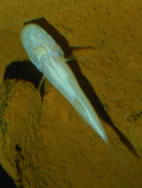Speoplatyrhinus
| Alabama cavefish | |
|---|---|
 |
|
| Scientific classification | |
| Kingdom: | Animalia |
| Phylum: | Chordata |
| Class: | Actinopterygii |
| Order: | Percopsiformes |
| Family: | Amblyopsidae |
| Genus: |
Speoplatyrhinus J. E. Cooper & Kuehne, 1974 |
| Species: | S. poulsoni |
| Binomial name | |
|
Speoplatyrhinus poulsoni J. E. Cooper & Kuehne, 1974 |
|
The Alabama cavefish (Speoplatyrhinus poulsoni), is a critically endangered species of amblyopsid cavefish found only in underground pools in Key Cave, located in northwestern Alabama, United States in the Key Cave National Wildlife Refuge. It was discovered underneath a colony of gray bats in 1967 and scientifically described in 1974.
On any single visit to the cave, no more than 10 individuals of this fish have been observed, and scientists estimate fewer than 100 are left. This fish is believed to be the rarest species of cavefish in the Unitrd States and one of the rarest of all freshwater fish. It exists in a fragile ecosystem based on nutrient-rich guano of the gray bat. Researchers have failed to find the fish in any other location.
The Alabama cavefish is one of the rarest cavefish species in North America. This species was discovered in 1967 by researcher John E. Cooper, and several specimens were observed over subsequent years. It was so unusual that he and co-author Robert A. Kuehne created a new genus for its description. The species is restricted to Key Cave in Lauderdale County, Alabama, with only 9 specimens having been collected (all before 1983). Because the underground water system in the area is so widespread, it was hoped that the cavefish had dispersed to other sites. However, studies of 120 other caves in the area, conducted since 1977, have failed to locate any other cavefish populations. No more than 10 individuals have been observed on any single visit to the Key Cave and in 36 visits from 1967 to 1998, the average was less than 4 per visit. The total number of individuals in the Key Cave population is estimated to be less than 100. Initially classified as vulnerable by the IUCN, its status has been gradually upgraded as its extreme rarity became apparent. It is currently considered critically endangered. Two reports of these fish in nearby Collier Cave are unconfirmed. Both caves are protected and inaccessible to the public.
...
Wikipedia

